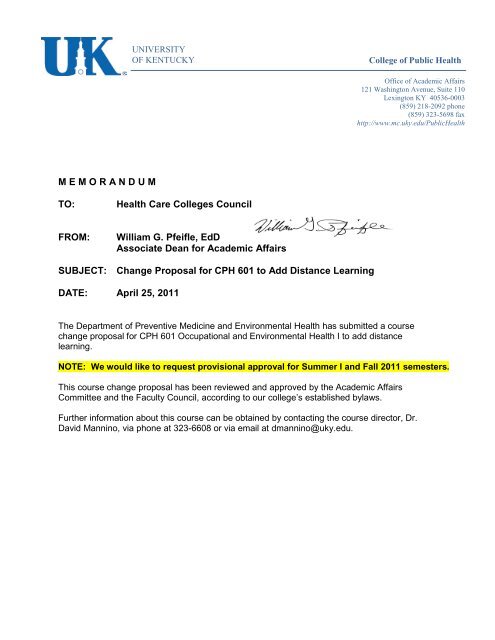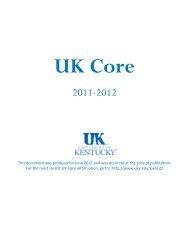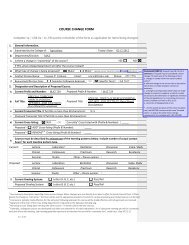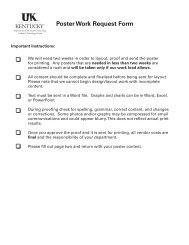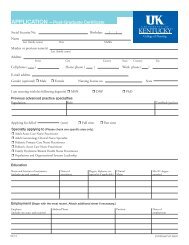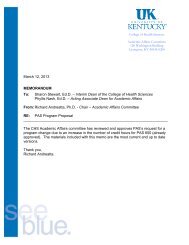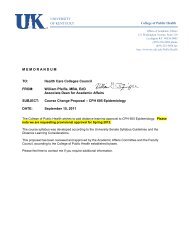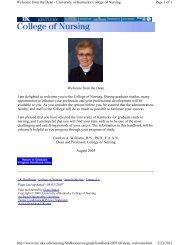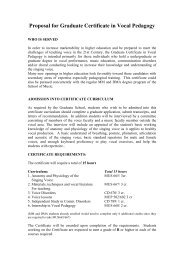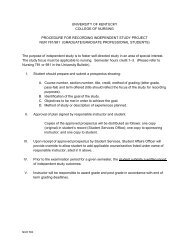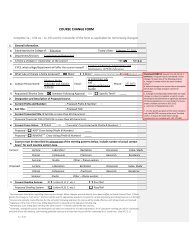CPH 601 - University of Kentucky
CPH 601 - University of Kentucky
CPH 601 - University of Kentucky
You also want an ePaper? Increase the reach of your titles
YUMPU automatically turns print PDFs into web optimized ePapers that Google loves.
UNIVERSITY<br />
OF KENTUCKY<br />
College <strong>of</strong> Public Health<br />
Office <strong>of</strong> Academic Affairs<br />
121 Washington Avenue, Suite 110<br />
Lexington KY 40536-0003<br />
(859) 218-2092 phone<br />
(859) 323-5698 fax<br />
http://www.mc.uky.edu/PublicHealth<br />
M E M O R A N D U M<br />
TO:<br />
Health Care Colleges Council<br />
FROM:<br />
William G. Pfeifle, EdD<br />
Associate Dean for Academic Affairs<br />
SUBJECT: Change Proposal for <strong>CPH</strong> <strong>601</strong> to Add Distance Learning<br />
DATE: April 25, 2011<br />
The Department <strong>of</strong> Preventive Medicine and Environmental Health has submitted a course<br />
change proposal for <strong>CPH</strong> <strong>601</strong> Occupational and Environmental Health I to add distance<br />
learning.<br />
NOTE: We would like to request provisional approval for Summer I and Fall 2011 semesters.<br />
This course change proposal has been reviewed and approved by the Academic Affairs<br />
Committee and the Faculty Council, according to our college’s established bylaws.<br />
Further information about this course can be obtained by contacting the course director, Dr.<br />
David Mannino, via phone at 323-6608 or via email at dmannino@uky.edu.
M E M O R A N D U M<br />
TO:<br />
FROM:<br />
SUBJECT:<br />
Linda Alexander, EdD<br />
Associate Dean for Academic Affairs<br />
Graham D. Rowles, PhD<br />
Chair, Faculty Council<br />
Approval – Course Change<br />
DATE: April 20, 2010<br />
At the March 9, 2010 meeting, the Faculty Council approved the following course change<br />
proposal:<br />
<strong>CPH</strong> <strong>601</strong> Env Health Change to add distance learning section<br />
This is now ready to proceed to the next stage <strong>of</strong> the approval process. Please do not hesitate to<br />
contact me if you need additional information or clarification.
MEMO<br />
DATE: March 2, 2010<br />
TO: Associate Dean for Academic Affairs<br />
FROM: Chair, Academic Affairs Committee<br />
SUBJECT: Course Change Approval<br />
<strong>CPH</strong> <strong>601</strong><br />
Occupational & Environmental Health - add Distance Learning
COURSE CHANGE FORM<br />
Complete 1a – 1f &2a – 2c. Fill out the remainder <strong>of</strong> the form as applicable for items being changed.<br />
1. General Information<br />
a. Submitted by the College <strong>of</strong>: Public Health Today’s Date: 1/25/2010<br />
b. Department/Division: Preventive Medicine and Environmental Health<br />
c. Is there a change in “ownership” <strong>of</strong> the course YES NO<br />
If YES, what college/department will <strong>of</strong>fer the course instead<br />
d. What type <strong>of</strong> change is being proposed Major Minor 1<br />
e. Contact Person Name: David Mannino Email: dmannino@uky.edu Phone: 3-6608<br />
f. Requested Effective Date: Semester Following Approval OR Specific Term 2 : Summer I 2011<br />
2. Designation and Description <strong>of</strong> Proposed Course<br />
a. Current Prefix and Number: <strong>CPH</strong> <strong>601</strong> Proposed Prefix & Number: same<br />
b. Full Title: Occupational and Environmental Health I Proposed Title: same<br />
c. Current Transcript Title (if full title is more than 40 characters):<br />
c. Proposed Transcript Title (if full title is more than 40 characters):<br />
d. Current Cross-listing: N/A OR Currently Cross-listed with (Prefix & Number):<br />
Proposed -<br />
Proposed -<br />
ADD Cross-listing (Prefix & Number):<br />
Remove 3,4 Cross-listing (Prefix & Number):<br />
e. Courses must be described by at least one <strong>of</strong> the meeting patterns below. Include number <strong>of</strong> actual contact<br />
hours 5 for each meeting and pattern type.<br />
Current: 45 Lecture Laboratory 5 Recitation Discussion Indep. Study<br />
Clinical Colloquium Practicum Research Residency<br />
Seminar Studio Other – Please explain:<br />
Proposed: 45 Lecture Laboratory Recitation Discussion Indep. Study<br />
Clinical Colloquium Practicum Research Residency<br />
Seminar Studio Other – Please explain:<br />
f. Current Grading System: Letter (A, B, C, etc.) Pass/Fail<br />
Proposed Grading System: Letter (A, B, C, etc.) Pass/Fail<br />
g. Current number <strong>of</strong> credit hours: 3 Proposed number <strong>of</strong> credit hours:<br />
1 See comment description regarding minor course change. Minor changes are sent directly from dean’s <strong>of</strong>fice to Senate Council Chair. If Chair<br />
deems the change as “not minor,” the form will be sent to appropriate Council for normal processing and contact person is informed.<br />
2 Courses are typically made effective for the semester following approval. No course will be made effective until all approval are received.<br />
3 Signature <strong>of</strong> the chair <strong>of</strong> the cross-listing department is required on the Signature Routing Log.<br />
4 Removing a cross-listing does not drop the other course – it merely unlinks the two courses.<br />
5 Generally, undergrad courses are developed such that one semester hr <strong>of</strong> credit represents 1 hr <strong>of</strong> classroom meeting per wk for a semester,<br />
exclusive <strong>of</strong> any lab meeting. Lab meeting generally represents at least two hrs per wk for a semester for 1 credit hour. (See SR 5.2.1)<br />
Rev 8/09
COURSE CHANGE FORM<br />
h. Currently, is this course repeatable for additional credit YES NO<br />
Proposed to be repeatable for additional credit YES NO<br />
If YES:<br />
Maximum number <strong>of</strong> credit hours:<br />
If YES: Will this course allow multiple registrations during the same semester YES NO<br />
i. Current Course Description for Bulletin: No change<br />
Proposed Course Description for Bulletin:<br />
j. Current Prerequisites, if any: No change<br />
Proposed Prerequisites, if any:<br />
k. Current Distance Learning (DL) Status: N/A Already approved for DL* Please Add 6 Please Drop<br />
*If already approved for DL, the Distance Learning Form must also be submitted unless the department affirms (by checking<br />
this box ) that the proposed changes do not affect DL delivery.<br />
I. Current Supplementary Teaching Component, if any: Community-Based Experience Service Learning Both<br />
Current Supplementary Teaching Component, if any: Community-Based Experience Service Learning Both<br />
3. Currently, is this course taught <strong>of</strong>f campus YES NO<br />
Proposed to be taught <strong>of</strong>f campus YES NO<br />
4. Are significant changes in content/teaching objectives <strong>of</strong> the course being proposed YES NO<br />
If YES, explain and <strong>of</strong>fer brief rationale:<br />
5. Course Relationship to Program(s)<br />
a. Are there other departments and/or programs that could be affected by the proposed change YES NO<br />
If YES, identify the departments and/or programs:<br />
b. Will modifying this course result in a new requirement 7 for ANY program YES NO<br />
If YES 7 , list the program(s) here:<br />
6. Information to be Placed on Syllabus.<br />
a. Check box if<br />
Changed to<br />
400G or 500<br />
If changed to 400G-or 500-level course you must send in a syllabus and you must include the<br />
differentiation between undergraduate and graduate students by: (i) requiring additional assignments by<br />
the graduate students; and/or (ii) establishing different grading criteria in the course for graduate<br />
students. (See SR 3.1.4)<br />
6 You must also submit the Distance Learning Form in order for the course to be considered for DL delivery.<br />
7 In order to change a program, a program change form must also be submitted.<br />
Rev 8/09
UNIVERSITY OF KENTUCKY<br />
COLLEGE OF PUBLIC HEALTH<br />
Updated May 21, 2011<br />
_______________________________________________________________________<br />
Course Syllabus<br />
<strong>CPH</strong> <strong>601</strong>: Occupational and Environmental Health I<br />
Weekend Course - Summer 2011<br />
________________________________________________________________________<br />
Room- TBD<br />
Time – Saturday Morning – 8 am- Noon, May 21, June 18, July 9<br />
________________________________________________________________________<br />
Contact information<br />
Instructor:<br />
David M. Mannino, M.D.<br />
College <strong>of</strong> Public Health, Room 214<br />
Teaching Assistants: Deepa Valvi (deepa.valvi@uky.edu)<br />
Telephone: 859-218 2099<br />
Cell - 859-797 2579 (Text preferred)<br />
E-mail:<br />
dmannino@uky.edu (preferred)<br />
I will make every attempt to respond to student communication within 24 hours. If you<br />
have not heard from me in this time frame- I’m probably traveling with limited access to E-mail.<br />
In that case, please contact Deepa.<br />
Office Hours: by appointment (or any time my door is open- most mornings)<br />
Feedback, questions, concerns - In addition to the above contact information, we will<br />
also make available on Blackboard a Course Comments/Concerns thread where<br />
questions/comments/concerns/ complaints can be posted and addressed. This can be done<br />
anonymously, if so desired (you just need to check the appropriate box). Please know that we<br />
try to be fair in assessing students work and in creating an interesting course. Please also accept<br />
that no course can please all students!
Course description<br />
<strong>CPH</strong> <strong>601</strong> covers theory and practice <strong>of</strong> assessing, controlling, and preventing environmental and<br />
occupational hazards that may adversely affect the health <strong>of</strong> present and future generations.<br />
Course prerequisites<br />
N/A<br />
Course objectives<br />
Upon completion <strong>of</strong> this course, the learner will:<br />
1. Identify basic principles and practice <strong>of</strong> environmental and occupational health.<br />
2. Recognize the broad scope <strong>of</strong> environmental health including the areas <strong>of</strong> water and air<br />
quality, food safety, hazardous waste management, and radiation protection.<br />
3. Identify multidisciplinary approaches <strong>of</strong> environmental and occupational health to protect<br />
public health.<br />
4. Understand how occupational and environmental health is central to the practice <strong>of</strong> public<br />
health.<br />
College <strong>of</strong> Public Health objectives in Preventive Medicine and Environmental Health<br />
This course is a key component <strong>of</strong> the educational program goals for the M.P.H., which is<br />
described in the most current student handbooks. Please reference the educational program goals<br />
throughout the semester, as they will provide a framework for this course and will contribute to<br />
your preparation for successfully completing other degree program requirements.<br />
Course Structure:<br />
The course will consist <strong>of</strong> seminar/discussion classes, lectures, web based learning, and selfstudy.<br />
The course will be enhanced by an online component in Blackboard, which will provide<br />
resources for accessing class materials including assignments and readings.<br />
Course Materials:<br />
A course packet, including the syllabus, will be made available prior to the first day <strong>of</strong> class to<br />
all students who are <strong>of</strong>ficially enrolled in the course. There is one required text for the class (see<br />
below).<br />
The syllabus and any course other course materials (including assignments) will be posted on<br />
blackboard.<br />
Textbooks<br />
Required
Basic Environmental Health Annalee Yassi, Tord Kjellstrom, Theo de Kok, and Tee Guidotti.<br />
Oxford <strong>University</strong> Press, 2001.<br />
This text will be a critical part <strong>of</strong> the course- All in class quizzes will come from the text<br />
and most <strong>of</strong> the blackboard assignments will also!<br />
Optional<br />
Occupational and Environmental Health: Recognizing and Preventing Disease and Injury. Fifth<br />
Edition. Editors: Barry S. Levy, David H. Wegman, Sherry L. Baron, & Rosemary K. Sokas.<br />
Lippincott Williams & Wilkins.<br />
Course requirements and learner evaluation<br />
Letter grades for the course will be assigned on a percentage basis (given below) for the total<br />
score as a percentage <strong>of</strong> the total number <strong>of</strong> points possible for the course.<br />
90-100 = A – 900 - 1000 points<br />
80-89 = B – 800 - 899 points<br />
70-79 = C – 700 - 799 points<br />
0-70 = E (Fail) -
The papers should be from 1500-2500 words in length, should have a minimum <strong>of</strong> 5 references,<br />
and will be graded on the quality <strong>of</strong> the paper, clarity <strong>of</strong> writing, understanding <strong>of</strong> the topic and<br />
its issues, quality <strong>of</strong> references, and organization. Students will be able to pick from one <strong>of</strong><br />
several topics (or chose one <strong>of</strong> your own with permission). The paper should focus on<br />
environmental or occupational health issues (i.e., for HIV this would need to focus on<br />
transmission in health care workers or commercial sex workers, etc.).<br />
Assignments are to be submitted electronically by the due date to dmannino@uky.edu . I will<br />
send a return e-mail acknowledging receipt. Submission MUST have file names in the following<br />
format <strong>CPH</strong><strong>601</strong>Paper Name. For my Outline it would be ‘<strong>CPH</strong><strong>601</strong>OutlineMannino.doc’ and<br />
for my paper it would be ‘<strong>CPH</strong><strong>601</strong>PaperMannino.doc’. This is done so I can be sure that the<br />
correct paper is graded and returned to the correct student. I will deduct 5-10 points if the<br />
documents are not labeled correctly! Assignments are to be done in Word (any version OK).<br />
The recommended components <strong>of</strong> the paper are:<br />
Background/History -<br />
50 Points<br />
Exposure level and risk assessment methods 50 points<br />
Mechanism <strong>of</strong> toxicity<br />
50 points<br />
Preventing/Controlling exposure 50 Points<br />
How it relates to today/Summary/Overview 50 points<br />
If these components do not work with you topic, please propose 5 components that will. The<br />
grading will be based on how well the issues are addressed in each component and how well the<br />
paper is written (I will deduct if there are spelling/grammar errors or if I have to work really hard<br />
to find the components <strong>of</strong> the paper)<br />
The outline <strong>of</strong> you paper is worth 50 points and is due by Midnight on June 12. This should be<br />
about 1 page and should briefly introduce the topic and address each component.<br />
Note that the assignments are generally due by Midnight on Sunday on the assigned dates. Late<br />
submissions will be accepted, with a 5% penalty for each day late. The papers will be submitted<br />
to safe-assign to evaluate potential plagiarism. As this is a review article, we will accept up to<br />
40% “duplication”. Above 40% points will be deducted from the total, commensurate with the<br />
amount <strong>of</strong> duplication, such that no points will be given if there is 90% duplication. Duplication<br />
from another student assignment (which are also in the database for both current and prior terms)<br />
is unacceptable.<br />
Paper Topics (or if something else interests you, please let me know):<br />
Chemical:<br />
Arsenic<br />
Asbestos<br />
Formaldehyde<br />
Lead<br />
Mercury<br />
Pesticides:<br />
a. DDT<br />
b. Atrazine<br />
c. Dieldrin<br />
Organic Solvents:<br />
a. Trichloroethylene<br />
b. Toluene<br />
c. Benzene<br />
Environmental Tobacco Smoke<br />
Nitrogen oxides (NOx)<br />
Polychlorinated Biphenyl’s (PCBs)<br />
Sulfur Dioxide (SO 2 )
Vinyl Chloride<br />
Physical:<br />
Non-ionizing radiation<br />
Ionizing radiation<br />
Heat stress<br />
Cold stress<br />
Particulate air pollution<br />
Biologic:<br />
HIV<br />
Hepatitis B<br />
Hepatitis C<br />
Food borne Illness<br />
a. Escherichia coli<br />
b. Listeria monocytogenes<br />
c. Clostridium perfringens<br />
d. Salmonella<br />
Bacillus anthracis<br />
Cryptosporidium<br />
Cholera<br />
Psychological:<br />
Depression<br />
Post Traumatic Stress Disorder (PTSD)<br />
Occupational Injuries:<br />
Fatal occupational injuries<br />
Musculoskeletal Disorders<br />
a. Carpal Tunnel<br />
b. Tendonitis<br />
c. Back pain<br />
Road traffic injuries<br />
Intentional injuries (Violence)<br />
Falls<br />
Technical Requirements<br />
As this is a class where the majority <strong>of</strong> work is done online, students must have access to a<br />
computer and to the internet. Black works best with the Firefox browser, but will work with<br />
Safari and Explorer. If you are having problems with Blackboard, I suggest that you try a<br />
different browser prior to calling the help desk.<br />
Blackboard Participation<br />
Blackboard participation accounts for 30% <strong>of</strong> your final grade (300 points). Blackboard will<br />
utilize class readings in the form <strong>of</strong> discussion questions from the weekly topics, or chapter<br />
review. Assignments on Blackboard are expected to be completed by the listed due date<br />
(Generally Midnight on Sunday). We are planning 12 assignments (one for each chapter,<br />
basically- 20 points apiece). To get full credit you must answer all the questions and show<br />
evidence that you read the chapter and put some thought into your response! Particularly good<br />
comments can get additional points (usually up to 5 points per posting).<br />
In addition, each student will be required to post a current events piece (worth 30 points) related<br />
to environmental health that other students will be required to comment ( 4 points per comment,<br />
30 points maximum as part <strong>of</strong> grade and up to 30 points for extra credit) on in Blackboard. This<br />
will be done based on a schedule that will be assigned following the first class. In addition, these<br />
topics will be addressed and discussed in the subsequent class. To get full credit (30 points),<br />
students should find and post on Blackboard Discussion Boards an interesting current events<br />
story that deals with an environmental health issue (10 points), submit to me a brief powerpoint<br />
presentation (3-6 slides) that explains the story (10 points), and asking 2 -3 insightful questions<br />
about the story that other students, after reading the story, can comment on (10 points). The<br />
current events postings are due at the same time as the Blackboard assignment for the assigned<br />
week (generally, Sunday at Midnight), and students will have an additional week to post their<br />
comments for credit.<br />
Blackboard 9 is a comprehensive and flexible e-learning s<strong>of</strong>tware platform that delivers course<br />
management for online learning at the <strong>University</strong> <strong>of</strong> <strong>Kentucky</strong>. The system can be accessed<br />
through the link blue portal.
Required Readings<br />
Required Readings are listed on the syllabus, and are expected to be completed each week prior<br />
to completing the online assignments. The readings are from the required text. If I decide<br />
additional readings are needed, I will post them on Blackboard.<br />
Extra Credit<br />
The extra credit opportunities include posting comments on current events (above the required<br />
ten) . Also, students can earn extra credit (typically 5 points/week) by providing very thoughtful<br />
responses on the weekly Blackboard assignments. We typically look through them and award<br />
additional points to the best 3 or 4.<br />
Instructor expectations<br />
1. I expect you to attend class. The components are highly interrelated; missing a class<br />
will detract from the learning potential <strong>of</strong> subsequent sessions.<br />
2. I expect you to be in the classroom and prepared to begin work at the scheduled<br />
starting time for each session.<br />
3. I expect (and encourage) you to provide honest and timely feedback regarding the<br />
content and process <strong>of</strong> this course throughout the semester.<br />
4. I expect you during the semester to interactively engage via Blackboard with the<br />
other students and the instructor.<br />
5. I expect you to share in the responsibility for making this course an enjoyable and<br />
beneficial learning experience.<br />
6. Wikipedia cannot be used as a cited reference as noted by a co-founder <strong>of</strong> Wikipedia!<br />
You may use Wikipedia to identify appropriate source material. Remember<br />
Wikipedia is not peer reviewed!<br />
Attendance/ Excused Absences<br />
This is a distance learning class, and class only meets three times. The following are acceptable<br />
reasons for excused absences and late assignments: 1) serious illness; 2) illness or death <strong>of</strong><br />
family member; 3) <strong>University</strong>-related trips (S.R. 5.2.4.2.C); and 4) major religious holidays.<br />
Students anticipating absence for a major religious holiday during the semester must notify the<br />
instructor in writing prior to the last day for adding a class. Information regarding dates <strong>of</strong> major<br />
religious holidays may be obtained through the religious liaison, Mr. Jake Karnes (257-2754).<br />
When there is an excused absence, students will be given the opportunity to make up missed<br />
work and/or exams. It is the student's responsibility to inform the instructor <strong>of</strong> the absence,<br />
preferably in advance, but no later than one week afterwards (S.R. 5.2.4.2.D). The burden <strong>of</strong><br />
pro<strong>of</strong> is on the student to provide sufficient documentation regarding the nature <strong>of</strong> the absence.<br />
For students seen at the <strong>University</strong> Health Service, the instructor will contact the staff there to<br />
help verify the "excusability" <strong>of</strong> an absence. The instructor may also contact a student's<br />
physician (upon obtaining student permission).<br />
If you know in advance that you will need to miss a class (because <strong>of</strong> a wedding or other similar<br />
unique event ) please contact the instructor in advance to make arrangements for assignments,
tests, etc. If you miss a class because <strong>of</strong> illness, you will need to contact the instructor as soon as<br />
you are able.<br />
Academic honesty<br />
Academic honesty is highly valued at the <strong>University</strong>. You must always submit work that<br />
represents your original words or ideas. If any words or ideas used in a class assignment<br />
submission do not represent your original words or ideas, you must cite all relevant sources and<br />
make clear the extent to which such sources were used. Words or ideas that require citation<br />
include, but are not limited to, all hard copy or electronic publications, whether copyrighted or<br />
not, and all verbal or visual communication when the content <strong>of</strong> such communication clearly<br />
originates from an identifiable sources. Please see the <strong>University</strong>’s policies concerning the<br />
consequences for plagiarism.<br />
Accommodations<br />
If you have a documented disability that requires academic accommodations, please see me as<br />
soon as possible during scheduled <strong>of</strong>fice hours. In order to receive accommodations in this<br />
course, submit to me a Letter <strong>of</strong> Accommodation from the Disability Resource Center<br />
(www.uky.edu/TLC/grants/uk_ed/services/drc.html). If you have not already done so, please<br />
register with the Disability Resource Center for coordination <strong>of</strong> campus disability services<br />
available to students with disabilities.<br />
Inclement weather<br />
The <strong>University</strong> <strong>of</strong> <strong>Kentucky</strong> has a detailed policy for decisions to close in inclement weather.<br />
The snow policy is described in detail at http://www.uky.edu/MicroLabs/documents/pweather.pdf<br />
or you can call (859) 257-5684.
Course schedule and topics<br />
Please note- this is subject to change – Also, the times are approximate.<br />
Week Month Date Topic Time Readings<br />
1 May 21 CLASS 1<br />
Pretest – <strong>CPH</strong> Certification Exam<br />
Dr. Mannino<br />
Review <strong>of</strong> Syllabus<br />
Overview <strong>of</strong> Competencies<br />
40<br />
minutes<br />
60<br />
Minutes<br />
60<br />
Minutes<br />
Review Information Packet \<br />
2 May 28 Talk 1 – Introduction (Online)<br />
Talk 2 – Toxicology (Online)<br />
Current Events<br />
3 June 4 Talk 3 – Risk Assessment (Online)<br />
Talk4 – Risk Management (Online)<br />
Current Events Bonus-<br />
4 June 11 Talk 5 – Air (Online)<br />
Talk 6 – Water (online)<br />
Current Events<br />
Current Events<br />
Paper Outline Due by June 12<br />
Basic Environmental Health<br />
(BEH) – Chapter 1<br />
Introduction<br />
BEH – Chapter 2<br />
Nature <strong>of</strong> Environmental<br />
Health Hazards<br />
+ Blackboard Assignment 1<br />
and 2 (due by Midnight May<br />
29)<br />
BEH Chapter 3<br />
Risk Assessment<br />
BEH – Chapter 4<br />
Risk Management<br />
+ Blackboard Assignment 3,<br />
4<br />
(due by midnight, June 5)<br />
BEH Chapter 5<br />
Air<br />
BEH Chapter 6<br />
Water and Sanitation<br />
+ Blackboard Assignment 5<br />
+ 6<br />
(due by midnight, June 12)
5 June 18 CLASS 2<br />
Quiz 1 – Chapters 1, 2, 3, 4,5,6<br />
Blackboard Review<br />
Current Events<br />
Talk 7 – Food (online)<br />
Talk 8 – Human Settlement (online)<br />
6 June 25 Talk 9 – Health and energy (online)<br />
Talk 10 – Industrial Pollution (Online)<br />
Current Events 9<br />
Current Events 10<br />
7 July 2 Talk 11 – Global Health (Online)<br />
Talk 12- Action (online)<br />
8 July 9 CLASS 3<br />
Current events 11<br />
Current events 12<br />
PAPER DUE ELECTRONICALLY- by<br />
Midnight –July 5)<br />
Current Events<br />
Class Discussion<br />
Quiz 4– Chapters 7,8,9,10,11, 12<br />
Post Test<br />
60<br />
Minutes<br />
60<br />
Minutes<br />
60<br />
Minutes<br />
60 min<br />
60 min<br />
60 min<br />
BEH Chapter 7<br />
Food and Agriculture<br />
BEH Chapter 8<br />
Human Settlement and<br />
Urbanization<br />
+ Blackboard Assignment 7<br />
and 8<br />
(Due by midnight, June 19)<br />
BEH Chapter 9<br />
Health and Energy use<br />
BEH Chapter 10<br />
Industrial Pollution and<br />
Chemical Safety<br />
+ Blackboard Assignment 9<br />
and 10 (Due by Midnight,<br />
June 26)<br />
BEH Chapter 11<br />
Transboundary and Global<br />
Health Concerns<br />
BEH Chapter 12<br />
Action to Protect Health and<br />
Environment<br />
+ Blackboard Assignment<br />
11 and 12 (Due by Midnight,<br />
July 5)
Blackboard Assignments:<br />
Chapter 1 ( 20 points) - Please Respond to these questions- either for your country <strong>of</strong> origin,<br />
one you have worked in, or one you are interested in!<br />
1. What proportion <strong>of</strong> people born in your country in the same year as you have already<br />
died, and what was the major cause <strong>of</strong> death<br />
2. Were any or many <strong>of</strong> these deaths related to the environment<br />
3. What will be the main health problems that you personally may encounter in the next<br />
30 to 40 years, based on the typical situation for adults in your country <br />
4. Will any <strong>of</strong> these health problems be related to the environment<br />
5. How do human activities and human health relate to sustainable development<br />
6. What are the differences in health (and disease patterns) between developed and<br />
developing countries What are the causes <strong>of</strong> these differences<br />
7. What differences are there between men and women in environmental risk What is<br />
the role <strong>of</strong> women in sustainable development<br />
8. What are the environmental health issues <strong>of</strong> particular importance to aboriginal people<br />
in your country<br />
9. In your chosen pr<strong>of</strong>essional role, which will be your most important environmental<br />
health concerns<br />
Chapter 2. ( 20 points)<br />
Give examples <strong>of</strong> reproductive effects caused by each <strong>of</strong> the following: a chemical,<br />
a physical agent, a biological agent, a mechanical hazard, and a psychosocial<br />
hazard.<br />
What type <strong>of</strong> evidence led you to the conclusion that each <strong>of</strong> the hazards you cited<br />
causes the effect in question.<br />
Chapter 3.<br />
(20 points)<br />
1. Consider all information that is needed to assess human exposure to a specific hazard.<br />
Consider how this information could be gathered.<br />
2. What are the advantages and disadvantages <strong>of</strong> environmental and biological monitoring
3. Which <strong>of</strong> the consequences indicated in Box 3.6 are directly or indirectly related to<br />
health Which <strong>of</strong> these impacts on human health can be expected to be positive or<br />
negative Which <strong>of</strong> these aspects would have to be taken into account in an EHIA, and<br />
what specific information would be needed to assess quantitative health risks prior to the<br />
onset <strong>of</strong> the project What would be needed to assess quantitative health risks prior to the<br />
onset <strong>of</strong> the project<br />
Chapter 4. (20 points)<br />
1. The construction <strong>of</strong> a depot for chemical waste is planned near a residential area. Several<br />
residents perceive this new situation as threatening to their health and that <strong>of</strong> their families.<br />
Give examples <strong>of</strong> possible coping strategies that can be characterized as emotion focused or<br />
problem focused.<br />
2. Consider the advantages and disadvantages <strong>of</strong> a "best practical means" approach as<br />
compared to an emission or effluent standard. Which best preserves environmental quality<br />
in nonpolluted areas Which best encourages the development <strong>of</strong> new abatement<br />
technology Which is most related to actual health effects<br />
3. Think <strong>of</strong> an example <strong>of</strong> the use <strong>of</strong> immunization in an occupational health context and<br />
consider the advantages and disadvantages <strong>of</strong> this practice. Should immunization be<br />
mandatory Why or why not<br />
4. Consider whether you agree with the statement that personal protective equipment<br />
should be a last resort. Why or why not Under what circumstances<br />
5. Consider to what extent the control measures at the person, indicated for the<br />
occupational environment, could also be effective to control for ambient exposures.<br />
Indicate if you regard such control options desirable for the general public.<br />
Chapter 5. (20 points)<br />
Please Respond to these questions- either for your country <strong>of</strong> origin, one you have worked in, or<br />
one you are interested in!<br />
1. Describe the specific composition <strong>of</strong> particulates and gaseous constituents <strong>of</strong> (1) wood<br />
smoke, (2) cigarette smoke, (3) automobile exhaust, and (4) emissions from a coal-fired<br />
power plant. Which has the most matter Which is predominantly gas Which is most<br />
complicated chemically Which is likely to be most dangerous<br />
2. Is air pollution a problem in your area What are the main sources What control<br />
measures are being used to reduce air pollution at the source along the path at the level<br />
<strong>of</strong> the person<br />
3. How have criteria for developing air quality been developed What are the scientific
and nonscientific issues in setting standards for air quality<br />
4. Is indoor air pollution a problem in your home What are the main sources<br />
5. How do you maintain air quality<br />
Chapter 6. (20 points)<br />
1. What factors need to be considered to develop an effective strategy to improve<br />
sanitation in a rural community <strong>of</strong> a developing country Of an urban community<br />
2. A number <strong>of</strong> initiatives and suggestions for better management <strong>of</strong> water resources have<br />
been discussed in this chapter. Try to develop other initiatives that could be used to<br />
promote water conservation. These could be economic, social, legal, or physical in nature.<br />
Think about how these may be implemented.<br />
3. Make a list <strong>of</strong> ten tips to reduce water consumption in a community affected by water<br />
shortage<br />
Chapter 7. (20 points)<br />
1. How can the HACCP concept be used to reduce the formation <strong>of</strong> Maillard reaction<br />
products<br />
2. Many different actions can be taken to improve the safety and quality <strong>of</strong> our food.<br />
Prepare a summary <strong>of</strong> these actions, indicating (a) the level at which this action should be<br />
taken and (b) the type <strong>of</strong> contaminant (biological or chemical) involved.<br />
Chapter 8. (20 points) Please Respond to these questions- either for your country <strong>of</strong> origin, one<br />
you have worked in, or one you are interested in!<br />
1. Is urbanization occurring in your area If so, why If not, why not, and do you<br />
think it will occur in the near future<br />
2. Is noise a problem in your area If so, what are the main sources<br />
3. Outline what you would do to decrease the incidence <strong>of</strong> road injuries in your<br />
jurisdiction.<br />
4. How would you apply the principles <strong>of</strong> "Healthy Cities" in your jurisdiction
Chapter 9. ( 20 points) Please Respond to these questions- either for your country <strong>of</strong> origin, one<br />
you have worked in, or one you are interested in!<br />
1. What energy sources are used most heavily in your home town<br />
2. What do you know about the hazards associated with them<br />
3. Are there alternatives that should be promoted<br />
4. What issues/difficulties can you think <strong>of</strong> in your country concerning the control <strong>of</strong> the<br />
energy-related factors listed above<br />
5. You are the environmental health <strong>of</strong>ficer on duty. You receive a call that there has<br />
been a small spill <strong>of</strong> irradiated water from the nuclear power plant. Using the approach<br />
outlined in Chapters 3 and 4, describe the steps you would take to address this problem.<br />
Chapter 10. (20 points)<br />
1. Consider the ethical issues that may arise in occupational health, particu1arly with<br />
respect to the competing interests <strong>of</strong> employers and workers. As an <strong>of</strong>ficial or consultant<br />
attempting to solve a problem related to an occupational hazard, how would you deal with<br />
these ethical issues<br />
2. Consider the situation for women in the workplace in your country. Is it likely that their<br />
health is affected differently from men's health by the conditions discussed in this section<br />
If so, how<br />
3. Consider the differences between industry-related (Le., occupational and<br />
environmental) health problems in developed countries compared to those in developing<br />
countries. How do these differences influence the programs that must be developed to<br />
manage these problems Consider the role <strong>of</strong> the various pr<strong>of</strong>essionals involved in<br />
assessing and managing industrial pollution.<br />
Chapter 11. ( 20 points ) Please Respond to these questions- either for your country <strong>of</strong> origin,<br />
one you have worked in, or one you are interested in!<br />
1. Your health minister has been invited to attend a special cabinet meeting to discuss<br />
your country's response to recent reports regarding climate change. She has been told that<br />
there are no major health impacts in your jurisdiction, therefore it is not necessary for her to<br />
prepare a detailed report. She has asked you if you think that she ought to attend. Formulate<br />
a memo <strong>of</strong> no more than two pages <strong>of</strong>fering her advice. Discuss how global warming could
affect health in your country.<br />
2. What are the most serious global health concerns Prioritize and justify your list.<br />
3. Summarize the areas <strong>of</strong> greatest debate and state why these debates exist.<br />
4. What are the obstacles to overcome in addressing global health problems<br />
5. What strategies exist to address these obstacles<br />
Chapter 12. (20 points )<br />
Assuming that you agree that pr<strong>of</strong>essionals should get involved, in the issues they study,<br />
what can you do with respect to each <strong>of</strong> the categories discussed in the section Role <strong>of</strong><br />
Environmental Health Pr<strong>of</strong>ession Be as concrete as possible, with specific examples <strong>of</strong><br />
actions that you might take.
Paper Assignments:


